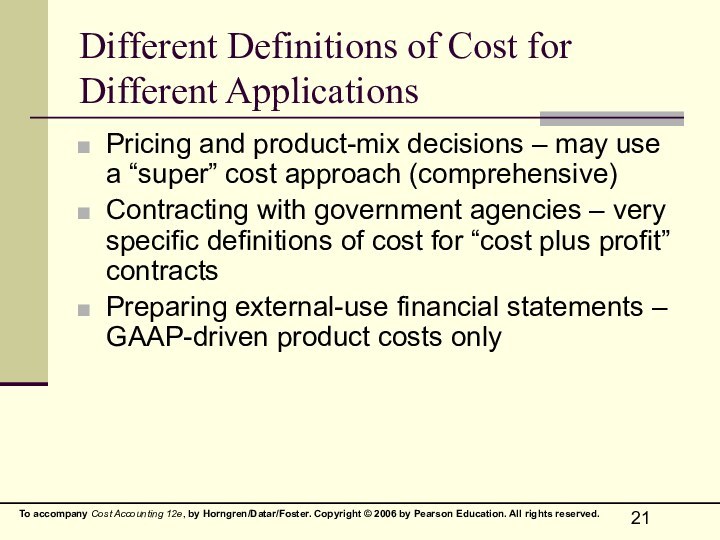Слайд 2
Basic Cost Terminology
Cost – sacrificed resource to achieve
a specific objective
Actual Cost – a cost that has
occurred
Budgeted Cost – a predicted cost
Cost Object – anything of interest for which a cost is desired
Слайд 3
Basic Cost Terminology
Cost Accumulation – a collection of
cost data in an organized manner
Cost Assignment – a
general term that includes gathering accumulated costs to a cost object. This includes:
Tracing accumulated costs with a direct relationship to the cost object and
Allocating accumulated costs with an indirect relationship to a cost object
Слайд 4
Direct and Indirect Costs
Direct Costs – can be
conveniently and economically traced (tracked) to a cost object
Indirect
Costs – cannot be conveniently or economically traced (tracked) to a cost object. Instead of being traced, these costs are allocated to a cost object in a rational and systematic manner
Слайд 5
Cost Examples
Direct Costs
Parts
Assembly line wages
Indirect Costs
Electricity
Rent
Property taxes
Слайд 6
Factors Affecting Direct/Indirect Cost Classification
Cost Materiality
Availability of Information-gathering
Technology
Operational Design
Слайд 7
Cost Behavior
Variable Costs – changes in total in
proportion to changes in the related level of activity
or volume
Fixed Costs – remain unchanged in total regardless of changes in the related level of activity or volume
Costs are fixed or variable only with respect to a specific activity or a given time period
Слайд 8
Cost Behavior, continued
Variable costs – are constant on
a per-unit basis. If a product takes 5 pounds
of materials each, it stays the same per unit regardless of whether one, ten, or a thousand units are produced
Fixed costs – change inversely with the level of production. As more units are produced, the same fixed cost is spread over more and more units, reducing the cost per unit
Слайд 9
Cost Behavior Summarized
Total Dollars
Cost per Unit
Variable
Costs
Change in
proportion with output
More output = More cost
Unchanged in relation
to output
Fixed
Costs
Unchanged in relation to output
Change inversely with output
More output = lower cost per unit
Слайд 10
Other Cost Concepts
Cost Driver – a variable that
causally affects costs over a given time span
Relevant Range
– the band of normal activity level (or volume) in which there is a specific relationship between the level of activity (or volume) and a given cost
For example, fixed costs are fixed only within the relevant range.
Слайд 11
A Cost Caveat
Unit costs should be used cautiously.
Since unit costs change with a different level of
output or volume, it may be more prudent to base decisions on a total dollar basis.
Слайд 12
Different Types of Firms
Manufacturing-sector companies – create and
sell their own products
Merchandising-sector companies – product resellers
Service-sector companies
Слайд 13
Types of Inventories
Direct Materials – resources instock and
available for use
Work-in-Process (or progress) – products started but
not yet completed. Often abbreviated as WIP
Finished Goods – products completed and ready for sale
Слайд 14
Types of Product Costs
Direct Materials
Direct Labor
Indirect Manufacturing –
factory costs that are not traceable to the product.
Also known as Manufacturing Overhead costs or Factory Overhead costs
Слайд 15
Distinctions Between Costs
Inventoriable Costs – product manufacturing costs.
These costs are capitalized as assets (inventory) until they
are sold and transferred to Cost of Goods Sold
Period Costs – have no future value and are expensed as incurred
Слайд 16
Cost Flows
The Cost of Goods Manufactured and the
Cost of Goods Sold section of the income statement
are accounting representations of the actual flow of costs through a production system.
Note the importance of inventory accounts in the following accounting reports, and in the cost flow chart
Слайд 17
Cost of Goods Manufactured
Calculates the cost of Direct
Materials Used
Accumulates the three product costs for the current
period
Adjusts the current period manufacturing costs to account for units actually completed
Слайд 18
Income Statement
Figure carries forward from the Schedule of
Cost of Goods Manufactured
Period Costs are expensed as incurred
Слайд 20
Other Cost Considerations
Prime cost is a term referring
to all direct manufacturing costs (labor and materials)
Conversion cost
is a term referring to direct labor and factory overhead costs, collectively
Overtime labor costs are considered part of overhead
Слайд 21
Different Definitions of Cost for Different Applications
Pricing and
product-mix decisions – may use a “super” cost approach
(comprehensive)
Contracting with government agencies – very specific definitions of cost for “cost plus profit” contracts
Preparing external-use financial statements – GAAP-driven product costs only





















